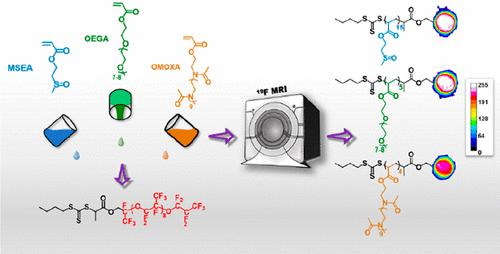当前位置:
X-MOL 学术
›
ACS Macro Lett.
›
论文详情
Our official English website, www.x-mol.net, welcomes your feedback! (Note: you will need to create a separate account there.)
Elucidating the Impact of Hydrophilic Segments on 19F MRI Sensitivity of Fluorinated Block Copolymers
ACS Macro Letters ( IF 5.8 ) Pub Date : 2022-09-15 , DOI: 10.1021/acsmacrolett.2c00414 Yiqing Wang 1 , Xiao Tan 1, 2 , Adil Usman 1, 2 , Yuhao Zhang 1 , Michał Sawczyk 3 , Petr Král 3, 4, 5, 6 , Cheng Zhang 1, 2 , Andrew K Whittaker 1, 2
ACS Macro Letters ( IF 5.8 ) Pub Date : 2022-09-15 , DOI: 10.1021/acsmacrolett.2c00414 Yiqing Wang 1 , Xiao Tan 1, 2 , Adil Usman 1, 2 , Yuhao Zhang 1 , Michał Sawczyk 3 , Petr Král 3, 4, 5, 6 , Cheng Zhang 1, 2 , Andrew K Whittaker 1, 2
Affiliation

|
A major challenge in the preparation of polymeric 19F magnetic resonance imaging (MRI) contrast agents (CAs) is signal attenuation caused by reduced segmental mobility of partly fluorinated polymers possessing large numbers of fluorine atoms. Previous studies have thus mainly focused on the development of fluorinated segments for improved 19F MRI; however, detailed investigations of the role of hydrophilic segments on imaging performance remain scarce. In this study, three hydrophilic and biocompatible monomers, i.e., 2-(methylsulfinyl)ethyl acrylate (MSEA), oligo(ethylene glycol) methyl ether acrylate (OEGA), and oligo(2-methyl-2-oxazoline) acrylate (OMOXA), were used to prepare perfluoropolyether (PFPE)-containing amphiphilic block polymers through reversible addition–fragmentation chain-transfer (RAFT) polymerization. The effect of the different hydrophilic segments on 19F imaging performance was explored. The three polymers could be readily dissolved in aqueous solutions, forming assemblies with the hydrophobic PFPE as the core and the hydrophilic chains as the shell. Molecular dynamics simulations demonstrate that the POMOXA chains adopt a rigid, extended conformation, leading to a relatively short 19F NMR spin–spin relaxation time (T2), lower NMR detectable 19F spins (i.e., visibility), and the least intense 19F MRI signal. In contrast, although PMSEA–PFPE has a shorter 19F NMR T2 than POEGA–PFPE, the much higher 19F spin visibility enhances its MRI signal intensity. The result confirms the importance of maintaining both high fluorine visibility and long T2 relaxation time to prepare effective CAs and highlight the key role of the nonfluorinated hydrophilic segments in determining these parameters.
中文翻译:

阐明亲水链段对含氟嵌段共聚物的 19F MRI 灵敏度的影响
聚合物19 F 磁共振成像 (MRI) 造影剂 (CA)制备中的一个主要挑战是由具有大量氟原子的部分氟化聚合物的链段迁移率降低引起的信号衰减。因此,以前的研究主要集中在氟化链段的开发上,以改进19核磁共振;然而,关于亲水链段对成像性能的作用的详细研究仍然很少。在这项研究中,三种亲水性和生物相容性单体,即丙烯酸 2-(甲基亚磺酰基)乙酯 (MSEA)、低聚(乙二醇)甲基醚丙烯酸酯(OEGA)和低聚(2-甲基-2-恶唑啉)丙烯酸酯(OMOXA) , 用于通过可逆加成-断裂链转移 (RAFT) 聚合制备含全氟聚醚 (PFPE) 的两亲嵌段聚合物。不同亲水链段对19的影响探讨了 F 成像性能。这三种聚合物可以很容易地溶解在水溶液中,形成以疏水性 PFPE 为核、亲水链为壳的组装体。分子动力学模拟表明,POMOXA 链采用刚性、扩展的构象,导致相对较短的19 F NMR 自旋-自旋弛豫时间 ( T 2 )、较低的 NMR 可检测19 F 自旋(即可见性),以及强度最低的19 F MRI 信号。相比之下,尽管 PMSEA–PFPE 的19 F NMR T 2比 POEGA–PFPE 短,但19F 自旋可见性增强了其 MRI 信号强度。结果证实了保持高氟能见度和长T 2弛豫时间对于制备有效 CA 的重要性,并强调了非氟化亲水链段在确定这些参数中的关键作用。
更新日期:2022-09-15
中文翻译:

阐明亲水链段对含氟嵌段共聚物的 19F MRI 灵敏度的影响
聚合物19 F 磁共振成像 (MRI) 造影剂 (CA)制备中的一个主要挑战是由具有大量氟原子的部分氟化聚合物的链段迁移率降低引起的信号衰减。因此,以前的研究主要集中在氟化链段的开发上,以改进19核磁共振;然而,关于亲水链段对成像性能的作用的详细研究仍然很少。在这项研究中,三种亲水性和生物相容性单体,即丙烯酸 2-(甲基亚磺酰基)乙酯 (MSEA)、低聚(乙二醇)甲基醚丙烯酸酯(OEGA)和低聚(2-甲基-2-恶唑啉)丙烯酸酯(OMOXA) , 用于通过可逆加成-断裂链转移 (RAFT) 聚合制备含全氟聚醚 (PFPE) 的两亲嵌段聚合物。不同亲水链段对19的影响探讨了 F 成像性能。这三种聚合物可以很容易地溶解在水溶液中,形成以疏水性 PFPE 为核、亲水链为壳的组装体。分子动力学模拟表明,POMOXA 链采用刚性、扩展的构象,导致相对较短的19 F NMR 自旋-自旋弛豫时间 ( T 2 )、较低的 NMR 可检测19 F 自旋(即可见性),以及强度最低的19 F MRI 信号。相比之下,尽管 PMSEA–PFPE 的19 F NMR T 2比 POEGA–PFPE 短,但19F 自旋可见性增强了其 MRI 信号强度。结果证实了保持高氟能见度和长T 2弛豫时间对于制备有效 CA 的重要性,并强调了非氟化亲水链段在确定这些参数中的关键作用。



























 京公网安备 11010802027423号
京公网安备 11010802027423号